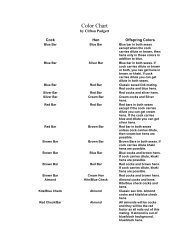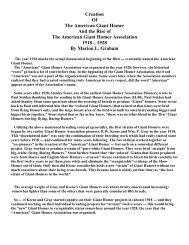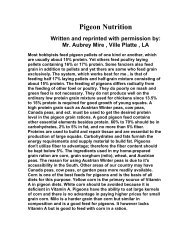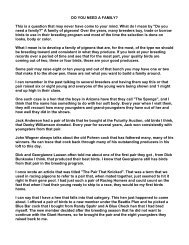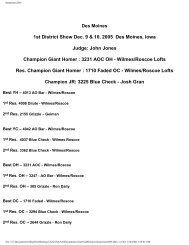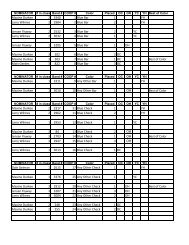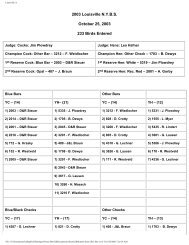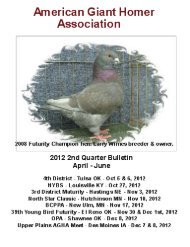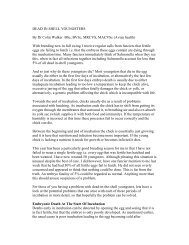Artificial Insemination of Pigeons and Doves.pdf - American Giant ...
Artificial Insemination of Pigeons and Doves.pdf - American Giant ...
Artificial Insemination of Pigeons and Doves.pdf - American Giant ...
Create successful ePaper yourself
Turn your PDF publications into a flip-book with our unique Google optimized e-Paper software.
<strong>Artificial</strong> <strong>Insemination</strong> <strong>of</strong> <strong>Pigeons</strong> <strong>and</strong> <strong>Doves</strong><br />
By Ray D. Owen, Dep't <strong>of</strong> Genetics<br />
University <strong>of</strong> Wisconsin, Madison, WI (Reprinted from Poultry Science 20: 428-431, 1941)<br />
Since the development by Quinn <strong>and</strong> Burrows (1936) <strong>of</strong> a simple method <strong>of</strong> obtaining semen<br />
from <strong>and</strong> inseminating gallinaceous (chicken-like) birds, artificial insemination has made<br />
possible a number <strong>of</strong> studies on the physiology <strong>of</strong> reproduction <strong>and</strong> hybridization <strong>of</strong> these birds.<br />
An extension <strong>of</strong> the technique to the smaller birds, particularly to the pigeons <strong>and</strong> doves, holds<br />
promise as a tool for more extended work along the same lines.<br />
The pigeons <strong>and</strong> doves include a wide variety <strong>of</strong> species, many <strong>of</strong> them separated by<br />
psychological <strong>and</strong> size barriers preventing normal copulation. Barriers <strong>of</strong> this sort can be<br />
surmounted by artificial insemination. In their physiology <strong>of</strong> reproduction, these birds <strong>of</strong>fer the<br />
same problems as those already studied by means <strong>of</strong> the insemination technique in<br />
gallinaceous birds, <strong>and</strong> in addition problems concerned with the specific <strong>and</strong> regular ovarian<br />
cycle not encountered in the Galena. Furthermore, certain types <strong>of</strong> pigeons (for example,<br />
featherless, rumpless) cannot copulate normally, <strong>and</strong> artificial insemination provides a possibility<br />
<strong>of</strong> reproducing these types.<br />
Bonadonna (1939) includes male pigeons, finches, <strong>and</strong> canaries in a list <strong>of</strong> birds, which have<br />
been ejaculated successfully in his laboratory by the "<strong>American</strong> method <strong>of</strong> pressing the semen<br />
from the bulbous ducts." He does not describe any modification in detail necessitated by the<br />
extension <strong>of</strong> the technique from large to small birds, <strong>and</strong> he does not record successful<br />
insemination <strong>of</strong> these small birds. His method <strong>of</strong> obtaining semen is undoubtedly the same as<br />
that to be described in this paper. It may nevertheless be considered worthwhile to place on<br />
record the details <strong>of</strong> the technique in its extension to small birds, <strong>and</strong> to describe a successful<br />
method <strong>of</strong> insemination in these species.<br />
I. Obtaining semen:<br />
The technique to be described is essentially that <strong>of</strong> Burrows <strong>and</strong> Quinn, modified in those details<br />
which are affected by the differences between large <strong>and</strong> small birds. The beginner will find it<br />
advantageous to work at first with relatively tame male pigeons <strong>of</strong> fairly large size. Later, when<br />
the technique is acquired, wild, (<strong>and</strong>) small birds can be trained to ejaculate. It is usually wise to<br />
keep males to be used for ejaculation in separate cages. Males kept together in large pens, or<br />
even males which are mated, can <strong>of</strong>ten be ejaculated regularly; in general, however, the yield <strong>of</strong><br />
semen from these males is small.<br />
A male to be ejaculated is held in the left h<strong>and</strong>, with his head toward the operator's left. The<br />
h<strong>and</strong> is extended along the bird's back with the fingers towards the tail <strong>and</strong> with the little finger<br />
hooked under the front <strong>of</strong> the right wing. The thumb <strong>and</strong> index finger are pressed against the<br />
opposite sides <strong>of</strong> the dorsal (top) surface <strong>of</strong> the pygostyle (the tail end <strong>of</strong> the vertebral column -<br />
the fleshy swelling to which the tail feathers are attached).<br />
The thumb <strong>and</strong> second finger <strong>of</strong> the right h<strong>and</strong> are pressed behind the tail <strong>and</strong> against the sides<br />
<strong>of</strong> the base <strong>of</strong> the cloacal projection, while the third finger <strong>of</strong> the right h<strong>and</strong> is pressed deeply<br />
between the pubic bones, immediately below the vent. If the position <strong>of</strong> the fingers is correct, by
pressing the h<strong>and</strong>s toward each other the vent can be made to appear, not as horizontal slit or<br />
as a small round hole, but as a wide opening in which the two ventral fleshy folds <strong>of</strong> the cloaca<br />
are exposed.<br />
The tail <strong>of</strong> the bird is now made to spread <strong>and</strong> fold alternately by a rhythmic pinching pressure <strong>of</strong><br />
the thumb <strong>and</strong> index finger <strong>of</strong> the left h<strong>and</strong> on the dorsal surface <strong>of</strong> the pygostyle. With the same<br />
rhythm, the fingers <strong>of</strong> the right h<strong>and</strong> "milk" the cloacal area. The vigor <strong>of</strong> the massage necessary<br />
varies with the male in use; some males require a quick, rough pressure while others yield better<br />
to slower, more gentle treatment. The manipulation should begin as soon as possible after the<br />
bird is caught, since delay decreases the probability <strong>of</strong> success. It will be found helpful to pluck<br />
clean <strong>of</strong> feathers, an area an inch or so in diameter around the vent, a day or two before<br />
attempting to obtain semen.<br />
A small, truncated cone into which the head, wings, <strong>and</strong> thorax, can be pushed has been found<br />
useful in holding large pigeons <strong>and</strong> small doves. The technique <strong>of</strong> the massage is not changed<br />
when the birds are held in this fashion. Usually after a second or two <strong>of</strong> massage a small drop <strong>of</strong><br />
clean milk-white semen will appear on the ventral (lower) surface <strong>of</strong> the cloaca. The yield <strong>of</strong><br />
semen can frequently be increased by continuing the stripping motion for a second or two after<br />
the first semen appears. Meanwhile, the thumb <strong>and</strong> forefinger <strong>of</strong> the left h<strong>and</strong>, which have been<br />
operating on the dorsal surface <strong>of</strong> the pygostyle, are slipped around the pygostyle <strong>and</strong> pressed<br />
deeply against the sides <strong>of</strong> the vent, holding the vent open <strong>and</strong> the drop <strong>of</strong> semen where it is<br />
easily seen <strong>and</strong> reached.<br />
This frees the right h<strong>and</strong> for the operation <strong>of</strong> an eyedropper, which can be used to collect the<br />
semen. In pigeons the quantity <strong>of</strong> semen averages from 0.01 to 0.02 cc per collection; the<br />
average collection contains about five to six million sperm. In domestic pigeons, the quantity <strong>of</strong><br />
semen does not appear to vary as a function <strong>of</strong> size <strong>of</strong> bird. Among species, however, smaller<br />
species are consistent in producing smaller quantities <strong>of</strong> semen per ejaculate. Most male<br />
pigeons can be ejaculated several times a day; if semen is collected from a male regularly more<br />
than once a day, however, that bird <strong>of</strong>ten become aspermic (without sperm).<br />
Occasionally, a male is found to be so susceptible to manual stimulation that after a brief<br />
massage, the fleshy folds <strong>of</strong> his cloaca erect <strong>and</strong> the bird goes through the twitching motion <strong>of</strong><br />
copulation, the erected folds being thrown well beyond the margin <strong>of</strong> the vent to form a pointed<br />
copulatory organ. Ordinarily, however, the male is quite passive <strong>and</strong> exhibits no copulatory<br />
reflex. Males <strong>of</strong> the latter sort require somewhat longer massage than do the more susceptible<br />
ones. If semen does not appear after 15 seconds <strong>of</strong> massage <strong>of</strong> any male he may as well be<br />
returned to his cage <strong>and</strong> tried again after an interval <strong>of</strong> not less than 15 minutes, with some<br />
variation in the technique or vigor <strong>of</strong> massage. In no case has a male pigeon or dove ejaculated<br />
with sufficient force to cause the drop <strong>of</strong> semen to lose its contact with the organ.<br />
Occasional contamination <strong>of</strong> the semen with urine or feces may be expected, particularly with<br />
untrained males. Frequently ciliates (microscopic organisms) appear upon microscopic<br />
examination <strong>of</strong> the apparently clean ejaculate. Granted the presence <strong>of</strong> large numbers <strong>of</strong> motile<br />
spermatozoa, however, these ciliates do not appear to affect fertility. Blood cells, probably the<br />
result <strong>of</strong> rupture <strong>of</strong> capillaries (tiny blood vessels) in the wall <strong>of</strong> the cloaca, are also occasionally<br />
found in the ejaculate.<br />
II. Inseminating
The semen collected can be introduced with the eyedropper directly into the oviduct <strong>of</strong> a laying<br />
female. It is neither necessary nor usually feasible to protrude the oviduct <strong>of</strong> the female as is<br />
commonly done with hens, turkeys, <strong>and</strong> guineas. The oviduct opens on the left side <strong>of</strong> the<br />
cloaca; by probing the eye- dropper to the left <strong>and</strong> somewhat dorsally, the opening <strong>of</strong> the oviduct<br />
can be discovered, the pipette pushed gently an inch or so into the oviduct, <strong>and</strong> the semen<br />
deposited there. While undiluted semen is effective in insemination, dilution <strong>of</strong> the collection with<br />
a drop or two <strong>of</strong> warm bird saline or Ringer's solution has proved productive <strong>of</strong> a greater<br />
percentage <strong>of</strong> fertile clutches.<br />
Female pigeons <strong>and</strong> doves do not ordinarily lay when they are isolated. Two methods have<br />
been successful in surmounting this obstacle; the first, which is most easily accomplished, is<br />
least efficient in its use <strong>of</strong> cage space. If a male <strong>and</strong> a female <strong>of</strong> the same species are put in<br />
adjacent cages where they can see <strong>and</strong> hear each other well (<strong>and</strong> there seems to be added<br />
stimulus to the female if the male can touch her through the bars or mesh <strong>of</strong> the partition), the<br />
female will usually lay regularly.<br />
The second method requires more attention. Two females placed in the same cage will <strong>of</strong>ten lay<br />
regularly. However, in this case the cycles <strong>of</strong> the two females soon approach coincidence, <strong>and</strong><br />
in order to establish the maternity <strong>of</strong> the eggs, the birds must be separated the day before the<br />
first egg <strong>of</strong> each is laid. A third method, which has not yet been tried, but which might be an<br />
improvement, would be to mate females for insemination with vasectomized males.<br />
Usually a female stimulated to lay by any <strong>of</strong> the methods mentioned above will incubate her<br />
eggs <strong>and</strong> rear the squabs. In the interest <strong>of</strong> more efficient use <strong>of</strong> females for insemination<br />
studies, however, it is <strong>of</strong>ten advisable to remove clutches as soon as they are complete. Eggs to<br />
be used for fertility determination or embryonic study may be transferred to an incubator <strong>and</strong><br />
incubated until the desired stage is reached. Eggs which are to be hatched <strong>and</strong> the squabs<br />
raised may be transferred to foster parents.<br />
It is, <strong>of</strong> course necessary that the foster parents be in the proper stage <strong>of</strong> their reproductive<br />
cycle, so that when the fostered young hatch they will be fed <strong>and</strong> cared for by parents whose<br />
crop gl<strong>and</strong>s are prepared to provide nourishment <strong>of</strong> the correct sort for the young. In order to<br />
insure this, the foster parents should be scheduled for hatching within a day or two <strong>of</strong> the date<br />
on which the fostered eggs are due to hatch.<br />
Fertility has been obtained from a single insemination as much as eight days <strong>and</strong> as little as one<br />
day before the first egg <strong>of</strong> a clutch was laid. In the latter case, only the second egg <strong>of</strong> the clutch<br />
was fertile. Our experiments indicate that the period included from the third to the sixth day<br />
before laying <strong>of</strong> the first egg is the period during which a single insemination is most likely to<br />
produce fertility. Multiple inseminations (for instance, inseminations on the third, fourth, <strong>and</strong> fifth<br />
days before the first egg <strong>of</strong> the clutch is laid) practically insure fertility in most intra-specific<br />
matings. The regularity <strong>of</strong> the ovarian cycle in pigeons <strong>and</strong> doves makes it possible to predict<br />
within narrow limits the date upon which an egg will be laid.<br />
The amount <strong>of</strong> semen required to produce fertility in pigeons <strong>and</strong> doves is considerably less<br />
than that recommended in gallinaceous birds. Thus, while Burrows <strong>and</strong> Quinn (1939) indicate<br />
that 0.1 cc <strong>of</strong> semen injected once a week will produce 80-95 percent fertility in most chicken<br />
matings, 0.01 c.c. diluted to 0.03 c.c. with warm bird saline has produced fertile clutches in 62<br />
percent <strong>of</strong> our trials with pigeons when the insemination occurred on the third to the sixth day<br />
before the first egg <strong>of</strong> the clutch appeared.
References<br />
Bonadonna T. 1939. <strong>Artificial</strong> <strong>Insemination</strong> <strong>of</strong> Birds. Seventh World's Poultry Congress <strong>and</strong><br />
Exposition, Proceedings: 79-82.<br />
Burrows WH <strong>and</strong> JP Quinn, 1939. <strong>Artificial</strong> <strong>Insemination</strong> <strong>of</strong> Chickens <strong>and</strong> Turkeys. Circular No.<br />
525, USDA, Washington, DC 12 pps, illus.<br />
Quinn JP <strong>and</strong> WH Burrows, 1936. <strong>Artificial</strong> <strong>Insemination</strong> <strong>of</strong> Fowls. J Hered. 27: 31-37, illus.<br />
______________<br />
Ray D. Owen, Dep't <strong>of</strong> Genetics<br />
University <strong>of</strong> Wisconsin, Madison, WI



